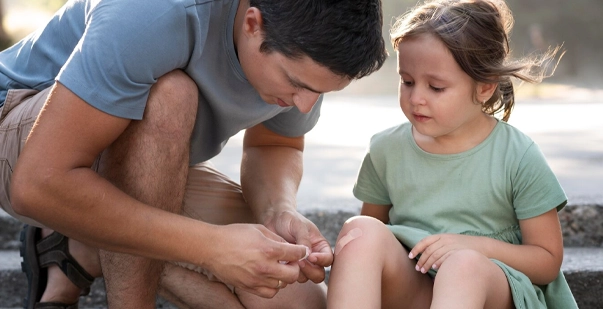Table of Contents:
- Introduction
- Understanding First Aid For Kids
- Creating a Safe Environment For Kids at Home
- Basic First Aid Skills For Parents
- Conclusion
Injuries and accidents are common occurrences in childhood. No matter how much parents try to protect their children, mishaps can happen at any moment, even in the safest environments. As a parent, being prepared for these unforeseen circumstances can make all the difference in how they are handled.
Research indicates that while the number of child fatalities from injuries has declined over the last 20 years, accidental injuries continue to be the top cause of mortality for children aged 1-4. This emphasizes how important it is for parents to have basic first-aid skills. Knowing how to provide first aid may enable parents to respond quickly and effectively in the event of any emergency, from a little cut to a major injury, possibly saving their child’s life.
In this article, we discuss essential steps required in first aid for parents, which will help them handle a child’s injuries confidently and carefully.
Master ACLS Now
Get ACLS certified with confidence
Understanding First Aid For Kids
Many parents feel overwhelmed when trying to ensure the safety of their children. While the desire to protect your child is strong, it’s not always easy to know where to start when it comes to first aid for parents. Babies and toddlers are prone to injuries like falls, burns, and choking.
Thus, as a parent, creating an infant first aid kit isn’t just about gathering bandages. It’s important to include essentials like an infant-friendly thermometer, antiseptic wipes, different-sized bandages, sterile gauze, and child-safe medications like ibuprofen and acetaminophen. But more than just assembling the kit, it’s equally important for parents to know how and when to use these items. Beyond having a first aid kit, parents should also learn CPR for babies and children, as the techniques differ significantly from adult CPR.
Also Read: Factors to Consider When Choosing a Pediatrician
Basic First Aid Skills For Parents
Mastering a few basic first aid skills can significantly impact a parent’s response to common emergencies involving their children. Therefore, parents should learn all the essential techniques as they prepare them to handle unexpected situations with confidence.
-
Handling Choking and Cardiac Arrest
Dealing with choking in a child can be incredibly stressful. It’s important to stay composed and assess the situation calmly. If your child can cough or speak, encourage them to keep trying, as this might help dislodge the object blocking their airway.
- If the child is unable to breathe, speak, or cough, perform the Heimlich maneuver. This technique involves administering abdominal thrusts to help expel the obstruction.
- In the worst-case scenario where the child loses consciousness and isn’t breathing, CPR could be helpful if you are trained to perform it. CPR is not only crucial for choking but is also vital in cases of cardiac arrest.
-
Stopping Bleeding for Cuts and Wounds
Bleeding from cuts and wounds can be particularly alarming, especially with young children who are prone to falls and scrapes.
- When a child is bleeding, apply direct pressure with a clean bandage or cloth on the wound. This helps to slow or stop the bleeding.
- For infants whose small blood volume makes even minor bleeding potentially serious, you should keep them lying down to manage shock and elevate the bleeding area above the heart level if possible.
- Do not attempt to remove any objects stuck in the wound, and always seek emergency medical help if the bleeding is severe or if signs of shock are present.
First Aid Tip: Apply direct pressure to a bleeding wound, keep the child warm, and seek emergency medical help if the bleeding is severe or persistent.
-
Treating Burns
Burns can range from minor to severe and pose a significant risk to young children due to their sensitive skin.
- For minor burns, running cool (not cold) water over the affected area for about 10 minutes can help ease the pain and reduce inflammation.
- Cover the burn with a sterile, non-stick dressing. Make sure to use a non-adhesive and sterile dressing. Serious burns, such as second-degree or third-degree burns, require immediate medical attention.
- Children’s skin burns faster and more severely than adults, so timely and appropriate care is essential.
First Aid Tip: For minor burns, cool the area under running water for 10 minutes, then cover with a clean bandage. Seek medical help for severe burns.
-
Managing Fractures, Sprains, and Bruises
Children are often active and can suffer from fractures, sprains, or bruises due to their frequent falls and bumps. It’s critical to understand how these injuries vary.
- Strains impact muscles or tendons, whereas sprains cause injury to ligaments.
- Fractures are breaks in bones, and dislocations occur when a bone moves out of its normal position.
- For suspected fractures or sprains, immobilize the injured area, apply a cold pack to reduce swelling, and follow the RICE method:
- R = Rest as much as possible
- I = Ice application to reduce pain
- C = Compression with elastic bandage to reduce swelling
- E = Elevation of affected body part
First Aid Tip: For suspected fractures or sprains, use the RICE method and seek medical evaluation. Immobilize the injured area and apply cold to reduce swelling.
-
Responding to Allergic Reactions
Allergic reactions in children can range from mild to severe, triggered by various factors such as food, insect stings, or environmental allergens.
- Mild reactions might cause sneezing, a runny nose, or a rash, which can often be managed with over-the-counter antihistamines.
- Severe reactions, such as anaphylaxis, require immediate medical attention. Hence, parents should consider recognizing symptoms early and call 911 immediately.
First Aid Tip: If you have a severe allergic reaction, use an epinephrine injection if prescribed. For mild reactions, use over-the-counter antihistamines and immediately contact a healthcare provider.
Also Read: AED Use on Children and Infants
Creating a Safe Environment For Kids
When it comes to children’s safety, prevention is extremely important. Parents can significantly reduce the risk of mishaps and crises by creating a safe environment. Below are a few tips to ensure your kids’ safety by improving home safety.
-
Childproofing Your Home
Childproofing involves identifying and addressing potential hazards around the house. For example, safety gates should be placed at the top and bottom of steps, electrical outlets should be covered to minimize shocks, and heavy furniture and walls should be secured to prevent tipping. Small objects, sharp tools, and cleaning supplies should also be kept out of reach.
-
Active Supervision
Constant attention is crucial during playtime and other activities. Supervision helps in preventing accidents before they occur. Recognize the typical circumstances that lead to injuries and stay alert during these times. For example, watch over kids as they play outside and make sure their play spaces are secure.
-
Teaching Basic First Aid
You can help your children learn basic first aid procedures. This can help them in situations where they are alone or where help isn’t immediately available. Teach them how to stop bleeding, assist someone who is choking, and contact emergency services. Make sure they know their full name, their parents’ names, home address, and phone number. They should also be aware that 911 is for emergencies only.
-
Preventing Accidental Poisoning
Store all potentially toxic substances, like cleaning agents and medications, in locked cabinets or high places. Keep lighters and matches out of reach to prevent burns and fires. Keep a check on safety devices such as fire detectors and carbon monoxide detectors are functioning properly.
Final Thoughts
Regular supervision during activities and teaching your children fundamental first aid techniques are vital aspects of first aid for parents. Additionally, parents must keep their first aid knowledge up to date by enrolling in a training program. With these practices in place, you can confidently address emergency conditions and safeguard your child’s well-being.
Overall, proactive safety measures combined with updated first-aid knowledge are necessary for the child’s care and protection.







